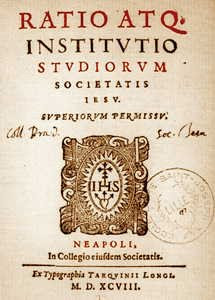The Jesuits were the first religious order to adopt formal education as a major ministry. Today in 1586 marks the issuance of a document titled Ratio atque Institutio Studiorum Societatis Iesu, known for short as the Ratio Studiorum. It refers to the “plan of studies” for Jesuit education. The final version was promulgated in 1599. Jesuit schools started in 1548 in Messina, and became one of the great education success stories.
By 1773, the year that the Society of Jesus was suppressed throughout the world by papal edict (it was restored in 1814), the Jesuits were operating more than 800 universities, seminaries, primary, and secondary schools around the globe. The world had never seen before, nor has it seen since, such an immense network of educational institutions operating on an international basis under a single aegis. Why were Jesuit schools so successful? According to Jesuit historian Father John O’Malley, there were several factors:
*No tuition (this changed later on, of course)
*Broad social span of its student body (and faculty): rich, middle class, and poor.
*Use of recitations, plays, and disputations in the curriculum
*The division of students into classes with an ordered progression. This was based on the modus parisiensis, the educational system at the University of Paris, which utilized progressive stages of education and employed various disciplines.
*They placed a stress on the inner appropriation of religious/ethical values
*There was an international network of schools
*Teachers better educated than most and try to teach by example. Interestingly, Ignatius discouraged corporal punishment, because he felt it lessened the respect a student ought to have for his teacher.
At the start, schools weren’t high on the Jesuits agenda, but their belief in doing whatever leads to God’s greater glory inevitably led them to the educational apostolate. Father O’Malley notes that they didn’t “understand the intrinsic dynamism that would change the organization undertaking it.”












